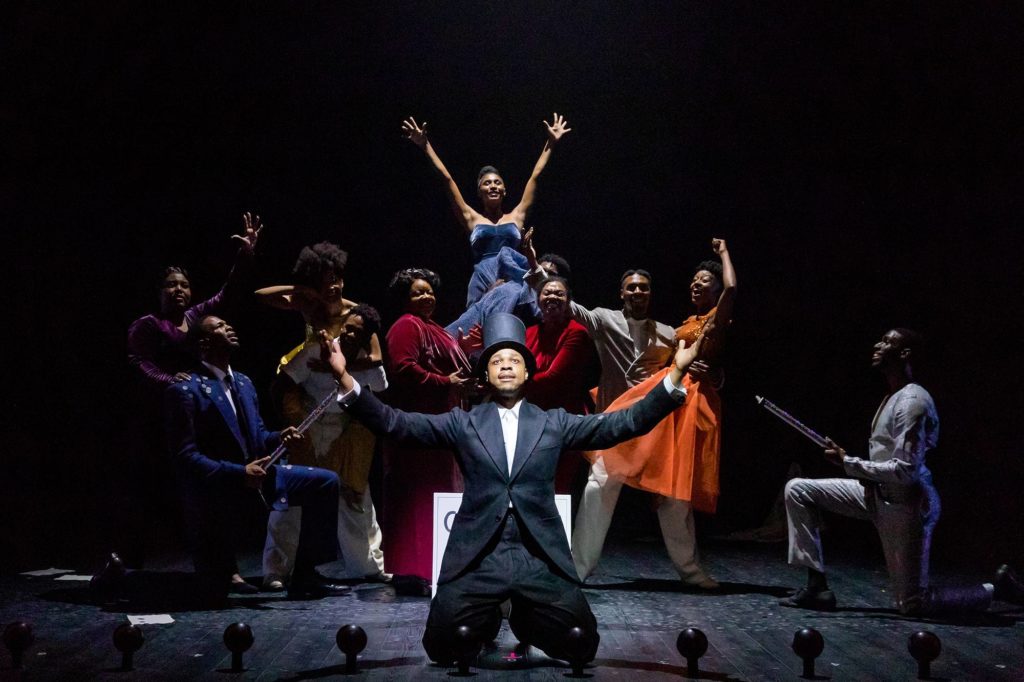
The Black Clown Production Photo
The cast of The Black Clown.
Photo: Maggie Hall.
Presented by American Repertory Theater
Adapted from Langston Hughes’ poem
Adapted by Davóne Tines and Michael Schachter
Music by Michael Schachter
Choreographed by Chanel DaSilva
Directed by Zack Winokur
Music Direction by Jaret Landon
Trumpets by Dave Adewumi and Robyn Smith
Keyboards played by Jaret Landon and Bethany Aikin
Reeds by Rajiv Halim, Isaiah Johnson, and Jason Marshall
August 31 – Sept 23, 2018
Loeb Drama Center
Harvard University
Cambridge, MA
ART on Facebook
Written by Bishop C. Knight
(Harvard Square, Cambridge, MA) In The Black Clown program, the A.R.T. Artistic Director wrote how “Langston Hughes drew deeply on the traditions of African American music,” and Hughes would have been pleased with this production.
The pit orchestra breathed life into spirituals and added rhythmic profundity to operatic adaptations of Hughes’ poems. Keyboards were played by Jaret Landon, a Chicago-based composer who was the show’s Music Director, and Bethany Aiken, who studied Music History at Oberlin College. A theater experience fusing vaudeville, gospel, and jazz, Black Clown brought Langston Hughes’ verse to life onstage. Every musician in this production – from the trumpet players, to the actors who themselves are acclaimed singers – every musician, per their participation in this production, paid respect both to Hughes and to the African American music at the heart of Hughes’ art.
From the start of the show, a girl in the row in front of me bobbed her head to the music, way before us stuffy adults got loose enough to hoot and clap and dance too. During the last few songs, there was no way to miss or resist the tambourine shaking of Jamar Williams, my favorite in this ensemble. Williams is a NYC-based actor who radiated joy on the stage and, at the end of the show, when the cast and creative team stood in front of the applauding audience, Williams took his bows before returning to his dancing. The curtain were closing while his hands clapped; Williams brightly smiling and his shoulders bouncing.
There are productions where actors are required to delve into individual characters. But after portraying Langston Hughes as representation of the common black man, Black Clown’s second important character of was black music itself and its universal catholicism. For me, since I was a teenager, I’ve idealized the Harlem Renaissance as a time of community, music, and celebration. There were rent parties in cramped apartments. Black women wore flapper dresses with fun feathered hats. Partners Lindy hopped at clubs. People danced as a happy hobby. Jamar Williams and his joy shone so that when he danced, especially during “Cry To The World,” he became a pure expression of Langston Hughes’ music and 1920s Harlem.
In an auditorium that suffered moments of being stiff and decorous – I mean, it is Harvard – the girl sitting in front of me and Jamar Williams danced whenever the spirit moved them. In a show that occasionally seemed overly rehearsed – I mean, it is Harvard – Williams channeled well timed spontaneity through his sparkling personality. Gratitude and good luck to this actor, an important presence in a talented cast!
— MUSIC in THE BLACK CLOWN —
- You Laugh
- I Am The Fool
- Strike Up The Music
- A Slave Under The Whip
- Nobody Knows
- Freedom!
- Black in a White World
- Sometimes I Feel LIke a Motherless Child
- Yet Clinging to The Ladder
- Day After Day
- N*gger
- Laugh At Me
- But No!
- Suffer and Struggle
- Say To All Foeman
- Cry To The World
Queen’s Note: The American Repertory Theatre does not regularly employ local actors, musicians or crew. Please consider this when deciding which shows to attend.
